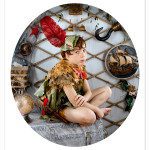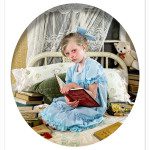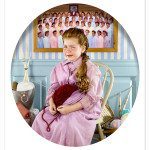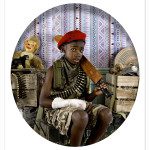Opening reception: Saturday, March 7 from 3-5pm
Jonathan Hobin : Cry Babies
The Choreography of Childhood in Jonathan Hobin’s Cry Babies
Text by Sasha Gora
A Boy Scout smears lipstick across his mouth, his lips and skin all the same. A girl wears a feathered headdress, a cigarette between her fingers and a bottle of booze in her hands. These scenes, which suggest that the kids are not alright, are two of the life-sized photographs in Jonathan Hobin’s new photo series Cry Babies.
Bright and exceptionally detailed, Cry Babies challenges colloquial representations of childhood. Hobin’s earlier series In the Playroom (2010) suggested a loss of childhood innocence through exposure to mass media reports of the violent power play of adults. Cry Babies puts childhood itself in the spotlight. But not as an innocent victim. Here it is complex, challenging, dark and troubling.
Philippe Ariès’ seminal 1960 Centuries of Childhood: A Social History of Family Life traces the development of a western concept of childhood and argues that it was only discovered in the 17th century. In the middle ages, it didn’t exist. Helen Schwartzman expands on this in her chapter “The Invention of Childhood”: “All children, because of the fact that they are born into a social environment, are affected by a construct that is peculiarly historical and, as such, has undergone many changes and reinterpretations in all societies.”
Hobin’s practice reveals these constructs. He creates arresting images that challenge stereotypes and engage with taboos. Rooted in storytelling, his work takes visual cues from popular culture, historical references, cinema and literature. What he produces are contemporary tableaux vivants. Gender, puberty, Neverland and the struggle to grow up, war and violence, religion, racial stereotypes, physical illnesses – the sixteen photos arranged in eight pairs of two address the dissonances in the choreography of childhood. Presented as photo diptychs that appear as images within lockets and “living” video portraits, Cry Babies exposes the contradictions and artifice rooted in Victorian era beliefs that continue to inform idealized representations of childhood in popular culture today. A locket is a way to wear an image close to one’s heart. They are romantic, sweet keepsakes and gifts, tidy compartments for memories. Hobin appropriates this as the format for his diptychs, suggesting dark secrets that are carefully kept tucked away.
Cry Babies calls out the bluff of candy-coated images of childhood. To suggest that childhood is only sugar and spice and everything nice is to engage in an adult game of make-believe.
1.Helen Schwartzman, Transformations: The Anthropology of Children’s Play (New York: Springer, 2013), 9.
Cry Babies – exhibition trailer









